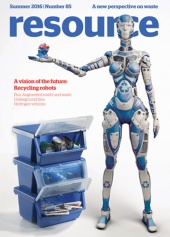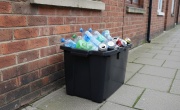The future of sustainable fashion
Fashion in the twenty-first century is far from sustainable – using up vast amounts of resources and damaging the environment, not to mention the human costs of sweatshop labour. Libby Peake investigates what is being done about it
Thanks in no small part to the meteoric rise of fast fashion, the ecological footprint of the clothing industry is in many ways second only to oil, and there are plenty of damning statistics to illustrate the dire state of affairs: in the US, 80 billion pieces of clothing are now purchased each year, 400 per cent more than just two decades ago.
The average American throws away 82 pounds of textile waste a year, mounting up to 11 million tonnes in the US alone (all according to the documentary The True Cost). In the UK, meanwhile, domestic clothing consumption has increased from one million tonnes in 2010 to 1.1 million in 2015, with England and Wales sending an estimated 620,000 tonnes to landfill (as of 2013/14), worth an estimated £140 million, according to WRAP figures. Moreover, the average household owns around £4,000 worth of clothes, nearly a third of which hasn’t been worn for at least a year, meaning that UK consumers are hanging on to roughly £30 billion of unworn clothes, according to WRAP’s 2012 ‘Valuing Our Clothes’ report.
That report (due to be updated later this year), also estimated that textiles accounted for five per cent of the UK’s total carbon and water footprints. The manufacture of textiles around the world (and most often in developing countries), meanwhile, requires vast amounts of natural resources (with one kilogramme of cotton requiring up to 20,000 litres of water to grow, for instance), and often results in hazardous gases, pesticides and dyes being released into the environment (by way of illustration, 50 million litres of toxic wastewater enter the Ganges every day from just the leather tanneries in Kanpur, according to The True Cost).
The rise in the amount of clothing available in the world also appears to be putting pressures on end markets (despite the fact that vast majority of unwanted textiles still wind up in landfill). In the UK, the amount of textiles collected for reuse and recycling increased nearly fivefold in the last 20 years, peaking at an estimated 650,000 tonnes in 2014 according to WRAP’s 2016 ‘Textiles Market Situation Report’, but it fell by an estimated four per cent in 2015, partly due to falling prices and lower demand in traditional end markets, some of which appear to be flooded.
Indeed, some overseas markets (where most of our donated used clothing is destined) have been struggling lately, and some East African countries are even considering banning the import of used clothing to their countries.
Asked why that might be the case, Leigh Mapledoram, WRAP Programme Area Manager for Sustainable Textiles, summarises: “I think there’s a feeling that they could grow their own textile production market.” Cécile Martin, WRAP Technical Specialist in Textiles, adds that there has long been a debate about the impact of exported clothing on countries’ domestic industries, especially “because Africa also receives first virgin goods from Asia, also of a lower quality”, though she cautions that WRAP has no official research on the impact. Meanwhile, according to The True Cost, donated clothing from the US has all but killed off the once- thriving local clothing industry in Haiti, where many used American textiles wind up.
So, in summary: there’s clearly plenty of work to be done if the clothing industry is to become more sustainable – from making production and design more resource-efficient, and phasing out dangerous chemicals, to ensuring clothing is more durable and has a sustainable outlet once it’s reached the end of its life as far as its first owner is concerned (and this is all before we even attempt to encourage people to consume less!). Here at Resource, we wondered what could be done to improve the situation; below are some projects and developments that could shape the industry for the better in years to come:
SCAP
The Sustainable Clothing Action Plan (SCAP) is WRAP’s major initiative when it comes to textiles, and is forming the basis for a European-wide action plan on clothing, ECAP. Its stated aim is to ‘improve the sustainability of clothing across its lifecycle’, and the signatories, representing 65 per cent of clothes sold in the UK by volume and 54 per cent by sales value, have committed to reducing carbon, water and waste to landfill per tonne of clothing by 15 per cent by 2020 (compared to a 2012 baseline), as well as reducing waste arising over the whole product lifecycle by 3.5 per cent.
In November 2015, WRAP announced that signatories had already achieved reductions of 12.5 per cent for water and 3.5 per cent for carbon, though waste arisings have remained constant, and landfilling figures are not expected to be reported until later this year. However, the fact that the commitment is per tonne of clothing, rather than overall impact, means that the impact of the UK’s fashion industry could still be growing. Mapledoram explains: “Because consumption is increasing, and because SCAP doesn’t cover the whole of the market either, it’s very difficult to say” whether fashion’s overall impact is reducing (adding that becoming more resource efficient “doesn’t mean to say that [clothing brands] want to sell any less”.)
A key part of SCAP’s work is focused on designing for longevity, with Mapledoram explaining: “The reason we focus on durability is because it’s one of the areas with the greatest gains in terms of carbon, water, and waste reduction.” And, indeed, WRAP figures suggests that extending the active use of clothes by just nine months would reduce carbon, water and waste footprints by around 20-30 per cent each and cut resource costs by £5 billion. To help businesses along the way, it has produced the ‘Sustainable Clothing Guide’, which provides tips on making clothing more durable – both in terms of physical attributes and emotional durability, which Martin explains as “making it relevant over time to people”. The guide identifies the top five actions for eight key product categories: children’s clothing, occasion wear, knitwear, tailoring, denim, sportswear, casualwear and underwear.
Some of the other developments listed below are also covered in WRAP’s extensive SCAP Knowledge Hub, which details different initiatives, processes and technologies that organisations could use in attempts to lessen their environmental impact.
Innovative materials
While materials such as organic cotton and recycled polyester are widely available and well known to be better for the environment than their more ubiquitous counterparts, there are plenty of other textile technologies in the offing that could lessen our clothing’s impact.
Traditional viscose manufacture, for instance, is currently in decline because of the high environmental costs associated with it. In its place, a few other man- made cellulosic fibres are coming to the fore, including lyocell, predominantly manufactured in Austria by Lenzig under the brand name TENCEL. The manufacturing process sees fast-growing Eucalyptus trees, which are grown on low-value land in South Africa, pulped with a recyclable solvent in a process that creates little waste, unlike traditional viscose manufacturing. Monocel, produced by Norwegian firm Nånkåtån, meanwhile, sees bamboo undergo a similar treatment to create another more sustainable viscose alternative.
In a more experimental vein, Suzanne Lee of BioCouture believes that organisms including bacteria, fungi and algae could be harnessed to produce the fabrics of the future. Explaining her project in a 2011 TED talk, she says: “I’m essentially using a kombucha [fermented tea] recipe, which is a symbiotic mix of bacteria, yeasts and other microorganisms, which spin cellulose in a fermentation process.” Using the process, she has been able to grow leather-like fabric in bathtubs, with the main downside at the minute being that she has “The reason we focus on durability is because it is one of the areas with the greatest gains in terms of carbon, water, and waste reduction” not yet been able to make the material waterproof. The potential upsides, though, are many: “What excites me about using microbes is their efficiency. So we only grow what we need. There’s no waste. And, in fact, we could make it from a waste stream – so for example, a waste sugar stream from a food processing plant. Finally, at the end of use, we could biodegrade it naturally.”
And there are others out there who are looking to go beyond creating waste-free materials to creating materials from waste. Companies are already making leather-like material from fish skins (see Resource 83), and replacing traditional insulation in winter coats with used coconut husks, and there are even plans afoot to create fabric (in part) from coffee grounds.
Low-impact dyes
While the environmental impact of dyeing depends on factors including the type of dye, type of material, and application method, dyeing can be a hugely polluting process, with the industry employing more than 8,000 chemicals, and requiring between 30 and 50 litres of water per kilogramme of textile produced, according to research from the University Institute of Fashion Technology at Panjab University. In her paper ‘Textile dyeing industry: An environmental hazard’, researcher Rita Kant lists the many harmful chemicals that can be present in widely-used synthetic dyes: ‘sulphur, naphthol, vat dyes, nitrates, acetic acid, soaps, enzymes, chromium compounds and heavy metals like copper, arsenic, lead, cadmium, mercury, nickel, and cobalt... formaldehyde-based dye fixing agents, chlorinated stain removers, hydrocarbon-based softeners, non-biodegradable dyeing chemicals [that] react with many disinfectants especially chlorine and form byproducts... that are often carcinogenic’.
Needless to say, then, it would be desirable for textile dyes to be more environmentally-friendly, and Martin says: “There’s a lot of progress that has been done on product finishes, which basically use much less water and fewer chemicals and that have quicker duration for the processes.” Low-impact dye produced by AVITERA®, for instance, for use on cellulosic fibres (cotton, for the most part), can be used by conventional mills and reportedly requires 50 per cent less water and reduces CO2 emissions by 50 per cent or more during the dyeing and washing off processes, whilst also reducing processing time. According to Huntsman, the company that manufactures the chemicals, if the entire world’s reactive dyed cotton was processed with AVITERA® SE, this could save more than 820 billion litres of water per year, equating to 1.3 litres of fresh water per person per day for the major textile processing countries like India, Bangladesh and China.
CO2 dyeing for polyester fibres, meanwhile, uses no water whatsoever. The technique, which has been developed by DyeCoo Textile Systems in the Netherlands, involves putting recycled (and recyclable) CO2 under high pressure, which turns it ‘supercritical’, giving it the properties of both a liquid and a gas. The resulting fabrics reportedly match the performance of conventionally-dyed polyester.
Changing consumer habits
While not necessarily a technical innovation, this is probably the area that needs the most attention if fashion is to become even remotely sustainable.
As journalist Lucy Siegel laments in The True Cost: “Instead of two seasons a year, we practically have 52 seasons a year, so we have something new coming in every week. And fast fashion has created this so that it can essentially shift more product.” Such a business model can never be sustainable on a finite planet, but there are, of course, other models we could look to.
 This article was taken from Issue 85
This article was taken from Issue 85The lend-lease business model – part of the burgeoning sharing economy – is one that could certainly be expanded a lot more. Mapledoram explains that, apart from for occasion wear, leasing or sharing clothing “obviously... isn’t mainstream yet, but that’s one of the areas that companies could move into”, adding that WRAP has found that some people, “particularly in a younger age group, would be interested in doing something in terms of a leasing model”. Nonetheless, there are examples already out there, including Rentez-Vous in the UK, which bills itself as a ‘guilt-free unlimited wardrobe’, where users can list items of clothing that others can then rent for a set price and period of time. And then there’s MUD Jeans, based in the Netherlands (and created in response to the founder’s experience of the fast fashion industry in China), which sees customers leasing jeans for life. After an initial joining fee, members pay €7.50 a month to rent jeans; after a year, they can switch to a different pair for a €10 fee. Returned jeans are upcycled into unique pieces named after their former users.
Some forward-thinking designers are also attempting to design more flexible single items of clothing. Polish label Blessus, for instance, creates modular constructions that allow customers to mix, match, or swap components using a series of concealed zippers to add or subtract pieces of fabric. Others are designing for disassembly (a phrase more usually associated with electronics), including Dutch companies Refinity and Dutchspririt, which have come up with the concept for a raincoat that can be disassembled for its components/materials after its first life. Refinity has also experimented with modular ‘fragment textiles’ that can be clicked together in various formations and removable prints that ‘combine short (fashion) cycles with long raw material cycles’. None of these are widely available (if, indeed, they are commercially available at all!), we certainly hope they soon come into fashion... 








